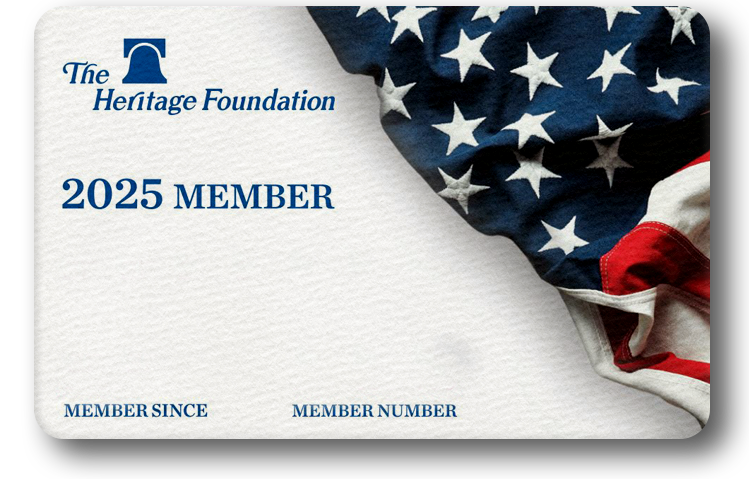Faith and religious practice are the foundational bedrock of culture upon which the morals, values, and principles of political governance of a nation rest. Religious institutions are pre-eminent pre-political institutions that deeply inform and influence social behavior and social norms as well as the character and content of laws, governance, and public policy.
Adherence to religious values is strongly tied to active and regular participation in religious practice. More than any other type of religious practice, frequent attendance of religious services is the most reliable predictor for individuals to act on their religious principles. Numerous studies have provided supporting evidence for what most people of faith already know: Frequent attendance of religious services has countless spiritual, emotional, psychological, and physical benefits for the well-being of individuals, families, and society.
This Backgrounder will illustrate the trends in religious services attendance in the United States over the past 50 years. A subsequent discussion will be given on some of the likely causes contributing to the decline in religious services attendance in the U.S. A brief review of the research literature on the social and individual benefits of frequent religious services attendance will also be discussed. The paper will conclude with policy recommendations for removing government barriers and restrictions to individuals’ free exercise of religion and belief, which are foundational to a free and just society.
How the Frequency of Religious Services Attendance Has Changed Over Time
In the past five decades, weekly and monthly attendance of religious services has declined significantly, while the share of Americans who never or rarely attend has doubled. Weekly attendance of religious services has declined for both the young and old alike, for both men and women, for blacks, whites, and Hispanics, and among both married and never married adults. Today, almost half of U.S. adults either never attend religious services or attend less than once a year.
Chart 1 shows the trends in religious services attendance in the United States over time. The data come from the General Social Survey (GSS), a nationally representative survey of U.S. adults ages 18 and over.REF The trend lines show the mean estimated percentage of Americans in each category. The shaded regions show the 95 percent confidence intervals (C.I.s) for the estimated mean percentages in each category.
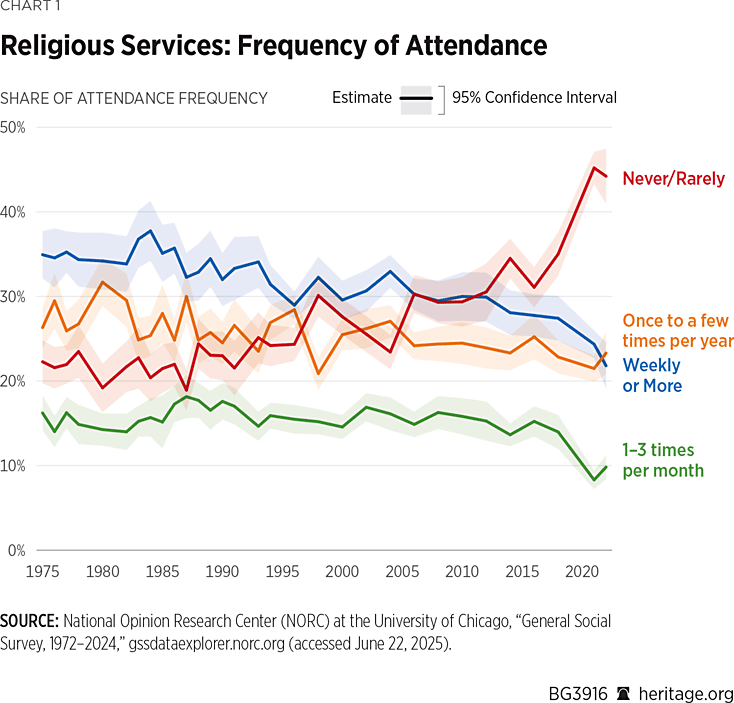
In 1975, about 35 percent of American adults attended religious services every week, nearly every week, or several times a week (95% C.I.: 32.1–37.7). But over time, fewer and fewer Americans went to worship regularly. By 2022, only 22 percent of Americans attended religious services at least once a week (95% C.I.: 19.0–24.6). The decline in weekly attendance from 1975–2022 is undeniable and on the order of statistical significance (two-sided p-value from a two proportions Z-test: p < 0.001).
These trends cannot be explained by any particular subset of the population. Weekly religious services attendance in the United States appears to have declined across nearly every demographic group. Between 1975 and 2022, weekly religious attendance declined significantly for women from 39 percent down to 25 percent (p < 0.001). For men, it fell from 30 percent to 18 percent (p < 0.001). Weekly religious services attendance by sex is shown in Chart 2.
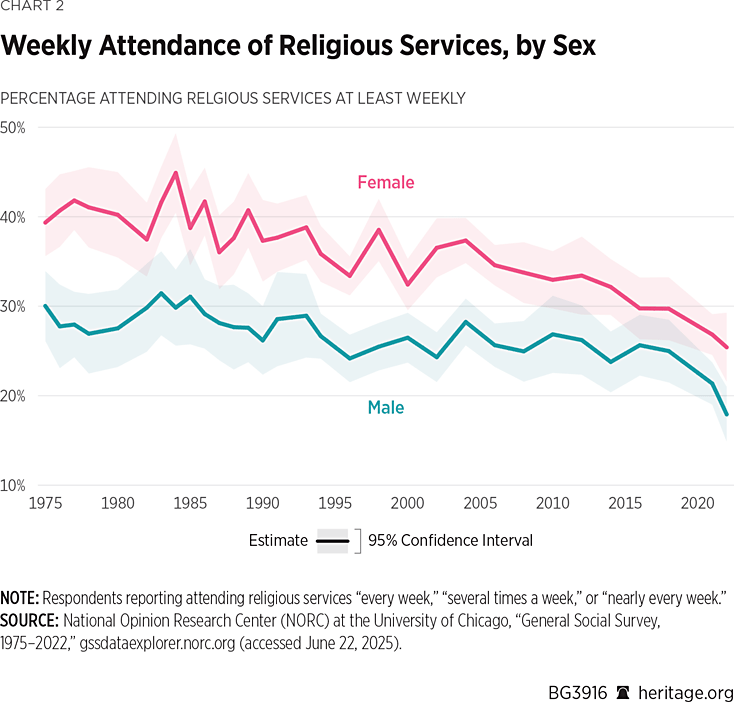
Chart 3 shows weekly religious services attendance by marital status. For married adults, weekly participation has dropped from 37 percent to 27 percent (p < 0.001). For never married adults, weekly participation has dropped from 30 percent to 14 percent (p < 0.001). Significant declines were also seen among the widowed (p < 0.01), but religious services attendance held steady for the separated and divorced and were statistically indistinguishable over time (p < 0.24).

Weekly religious services attendance has also declined across all age groups. Chart 4 shows weekly religious services attendance for U.S. adults by age group. There is strong evidence that weekly attendance has declined for U.S. adults 18–29, 30–39, 40–49, 50–59, and 60+ years of age (for ages 18–29 and 40–49, p < 0.01, and for ages 30–39, 50–59, and 60+, p < 0.001). In 1975, 26 percent of young adults 18–29 years old attended religious services at least weekly, but by 2022, it had dropped to only 15 percent. For Americans in their thirties, it fell from 29 percent to 14 percent. Even those 60 years of age and over saw their participation decline from 44 percent down to 32 percent.
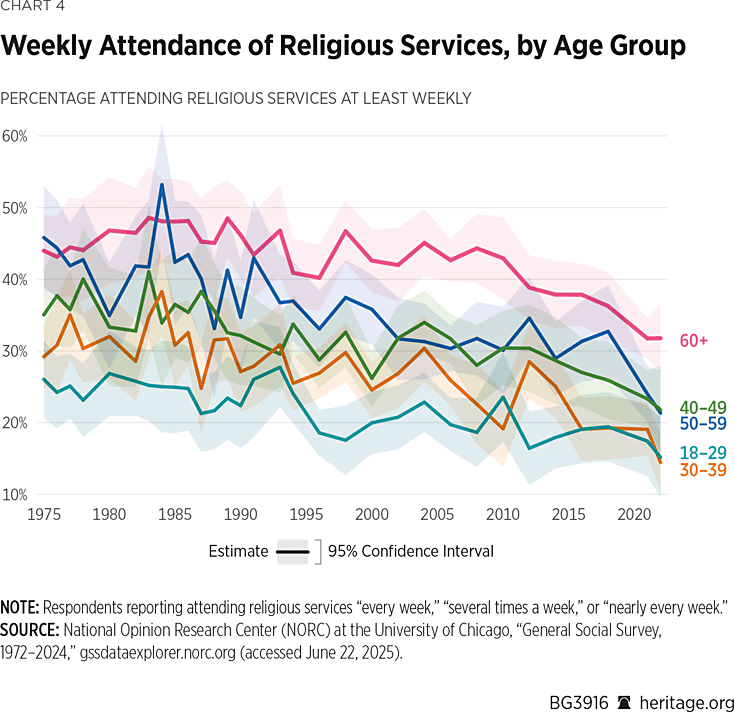
Chart 5 shows attendance of religious services by race. Since the year 2000, weekly attendance fell significantly for Caucasians from 28 percent to 21 percent (p < 0.001), from 37 percent to 27 percent for African Americans (p < 0.03), and from 31 percent to 20 percent for Hispanics (p < 0.02).
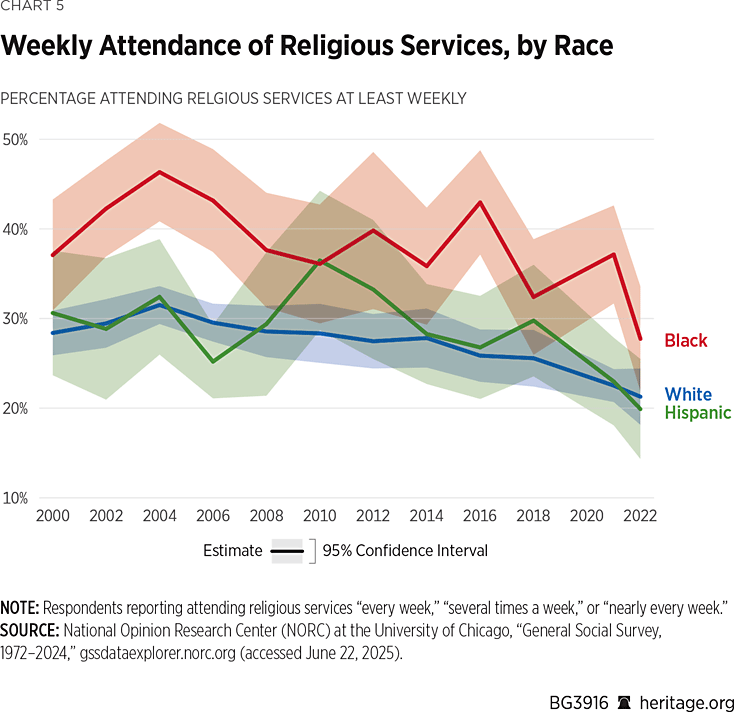
Breaking down religious services attendance by highest level of educational attainment (Chart 6), it appears that much of the decline in religious services attendance since 1975 is among Americans with a high school diploma or less. Since 1975, religious services attendance has not declined on the order of statistical significance among Americans with an associate’s, bachelor’s, or graduate degree (associate’s degree: p = 0.45; bachelor’s degree: p = 0.07; graduate degree: p = 0.08). But Americans with a high school diploma or less have seen their attendance rates drop significantly. In 1975, 34 percent of Americans with less than a high school diploma attended religious services weekly. But by 2022, this has dropped to 12 percent (p < 0.001). Similarly, Americans with a high school diploma as their highest degree earned saw their weekly participation rates drop from 36 percent in 1975 to 21 percent in 2022 (p < 0.001).
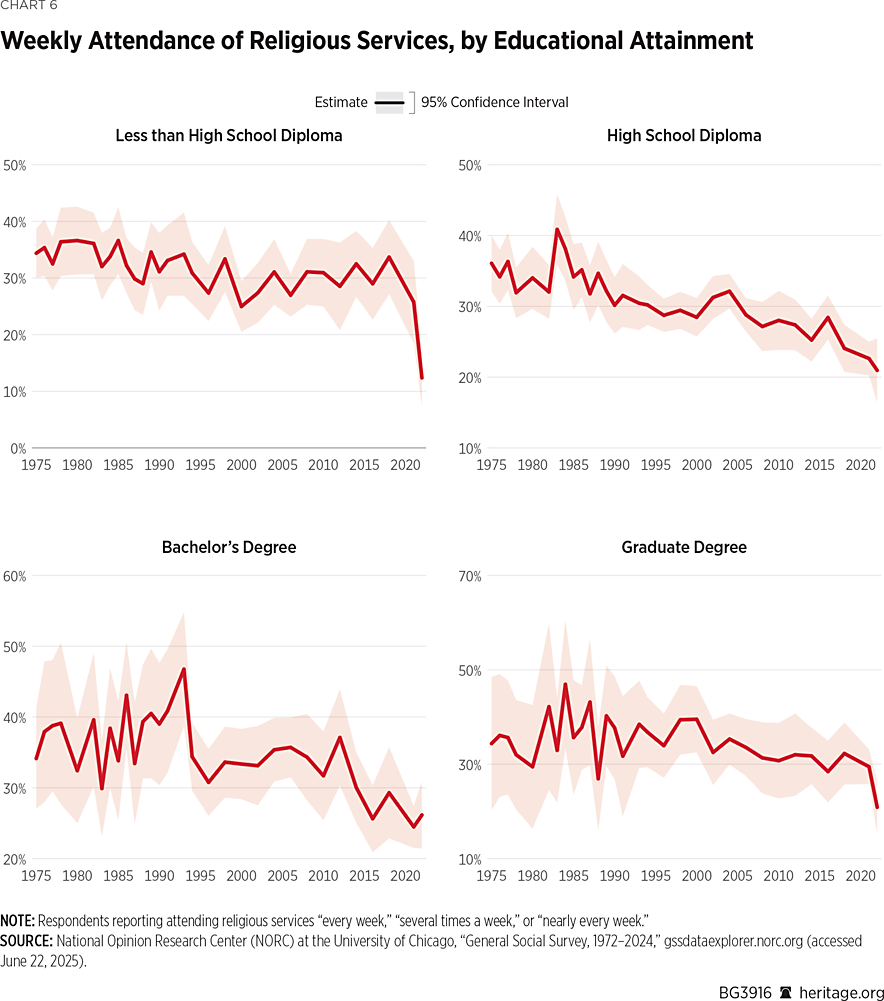
Declines in religious services attendance in the U.S. was concentrated in states on the East Coast and in the Midwest. Map 1 shows the change in the proportion of Americans who attended religious services on a weekly basis by region between 1975 and 2022. The regions shaded in dark blue are regions where the change in the share of Americans attending weekly services declined on the level of statistical significance. For example, in 1975, 34 percent of New Englanders attended services weekly, but by 2022, only 12 percent did. The difference in proportions is 0.22 (as shown by the label corresponding to New England in Map 1), and this decline in attendance was statistically significant (p < 0.01). Meanwhile, weekly religious services attendance increased by 0.04 in the Pacific region (Alaska, California, Hawaii, Oregon, and Washington), but the increase was not statistically significant.
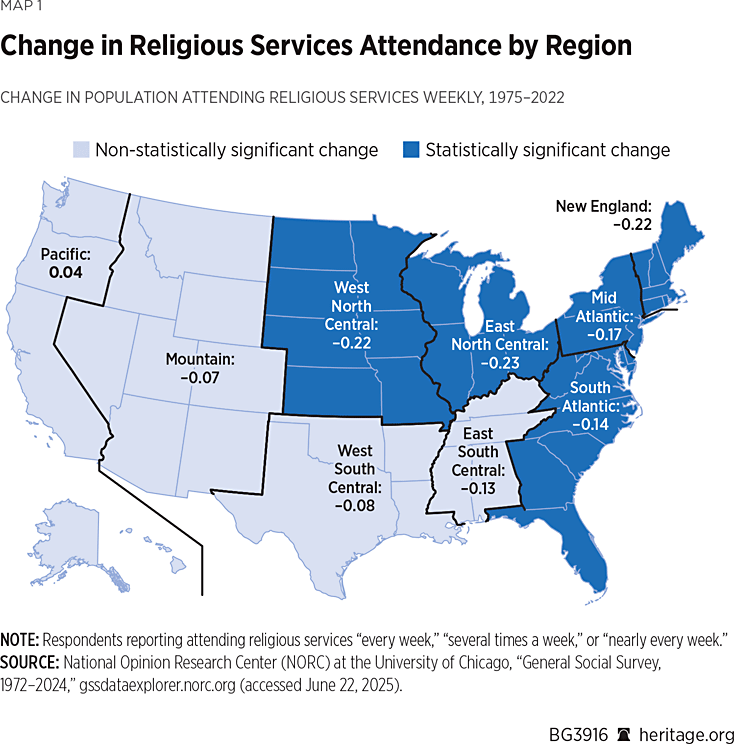
But it is not just weekly attendees who showed a decline in religious participation. The religious services attendance of Americans who attend one to three times a month were heavily impacted by the COVID-19 pandemic. The percentage of Americans attending on a monthly or multi-monthly basis had remained stable for nearly 50 years, but after the pandemic, there was a sharp decline in religious services attendance for this group (see Chart 1). For Americans who attend religious services once or only a few times a year, there was no statistically significant change in attendance over the past 50 years (p = 0.08). The only attendance frequency category that saw growth after 1975 were those who rarely or never attend religious services. In 1975, about 22 percent of Americans rarely or never attended services (95% C.I.: 19.7–24.8), but by 2022, it had risen to 44 percent (95% C.I.: 40.9–47.5).
Although the pandemic may explain some of the recent decline in attendance of religious services, Charts 1–6 indicate that attendance had already been falling for decades prior to COVID-19. Why then has attendance of religious services been steadily declining in the United States?
Why Religious Services Attendance Is Declining
The reasons for the decline in religious participation are numerous, complex, and, in many respects, unclear. But perhaps one of the most salient reasons is the seismic cultural shift in values and norms that has taken place in the U.S. during the past five decades.
Changing Culture and Values. Since the 1960s and early 1970s, society has become broadly more accepting of divorce, sexual relations outside marriage, contraception, abortion, homosexuality, transgenderism, assisted suicide, gambling, and recreational drug use.REF All of these activities are contrary to the morals, teachings, and values of most religious traditions. The fact that many Americans have come to accept and participate in these sorts of activities has changed personal values and philosophies and has caused people to distance themselves from religious institutions and the observance of religious services. When more and more people become accepting of all forms of immorality, society ceases to support religious values, and religious believers pay a higher social cost for going against the cultural grain.
Materialism and “Achievism.” But society and culture have also changed in other ways. For one, society has become increasingly obsessed with getting ahead in life both materially and in terms of status. After the Baby Boom, family sizes shrankREF as parents began placing more value on spending more timeREF and resources on fewer children. With more attention from their parents, children have increasingly grown up in a climate in which they are pushed to achieve and in which they feel that they are, in a sense, defined by their material achievements and status. And as the modern economy becomes more specialized and more information-based, young adults increasingly feel pressured to achieve more and stay longer in education to improve their earnings potential.
The increasing role that digital and social media have played in people’s lives during the past 25 years has amplified the effect, making people more aware of what the Jones’ have. This has driven adults and adolescents today to gain ever more external markers of achievement. The increasing appetite for worldly achievements has increased the amount of importance Americans place on money, as surveys have shown,REF as well as the amount of time and the value Americans place on leisure. The cultural pressure to achieve more has gone hand-in-hand with an increased focus on individual autonomy and personal choice in the U.S. Many young adults, in pursuit of educational and material achievements and financial goals, have increasingly put off marriage and family—two institutions that often bring people back to regular church attendance.
These factors and dynamics have created a culture of “achievism” that seeks to maximize individual autonomy, financial success, work, and time spent in leisure and in raising a small number of children where children are increasingly being treated as achievements as well. Between work, school, meeting up with friends, getting homework done, and shuttling kids to soccer games, Americans are increasingly pressed for time, and the cultural shift in priorities means there is less time for religious observances. Because religious practice tends not to fit into the priorities of contemporary society, fewer Americans see religious practice as relevant to their lives.
Social Engagement. As achievism in American culture has become more predominant, community and extended family ties have weakened, and with them, the institution of marriage. More individualism and fewer family and community ties have translated to a significant decline in in-person social engagement in the U.S. over the past two decades.REF Americans today are less impelled to attend religious services because fewer and fewer Americans have a family, friends, or a community motivating them to go. And when they do go, they have less practice with in-person social skills and are probably less likely to connect with other congregants or feel a sense of belonging.
Secularization. For decades, Americans have also increasingly faced the cultural pressure of enforced secularization. It has increasingly become seen as impolite to express or exercise one’s religious beliefs in public. As a result, most people self-censor and keep their religion to themselves. The public square has become sanitized of religious practice and beliefs and, as a result, most people do not encounter faith in society in their day-to-day experiences. Religion often becomes personally less important in life when society no longer recognizes its importance and no longer practices it publicly.
Distancing from Religious Beliefs and Institutions. Another salient reason for the decline in religious observance is the rising share of Americans who have distanced themselves from religious institutions. For one, many have fallen away due to doubts or skepticism about religious teachings.REF Many have additionally distanced themselves from religious institutions in response to reports of scandals and the moral failings of religious leaders in recent decades. Others appear to have left as a result of negative interactions with religious leaders or adherents.REF Changing cultural norms has also meant that fewer people align their personal values and life choices with the teachings of most religious institutions, causing potential congregants to feel guilt and discomfort around religious people and functions. Surveys have shown that persons who do not ascribe to any particular religious affiliation and are not a member of a particular religious community are, unsurprisingly, much less likely to attend religious services.REF
Comfort and Wealth. Declining religious observance in the United States may also be occurring as an unintended consequence of the ease of modern life and increasing per capita wealth. When life is good, some people take their blessings for granted and fall away from religious practices. On the other hand, people tend to return to them when times are hard. The data appears to support this theory. Weekly attendance of religious servicesREF in 2015 tended to be lower in countries that have higher life expectancyREF (Spearman’s rank correlation: p = -0.70) and higher gross domestic product (GDP) per capitaREF (Pearson’s correlation: p = -0.70).REF Increasing wealth and life expectancy in the U.S. within the past 50 years are categorically positive developments, but religious services attendance may have suffered setbacks as an unfortunate unintended consequence.
Whatever the causes may be, the importance Americans place on religion in their personal lives is on the decline. According to polling from Gallup, 65 percent of respondents said religion was “very important” in their life in 1965, but by 2023, only 45 percent of respondents did.REF Meanwhile, the percentage of Americans who said religion was “not very important” in their life rose from 7 percent to 30 percent.REF In the Pew Research Center’s National Public Opinion Reference Survey, the percentage of Americans who say they pray on a daily basis fell from 58 percent to 45 percent between 2007 and 2021.REF Whether declining importance of religion is a cause or a symptom of declining religious practice is unclear, but in any event, Americans are placing less importance on religion, generally.
Frequent Religious Services Attendance Benefits Society
The decline in religious services attendance will inevitably have broad ramifications for the health and well-being of society. There is ample evidence that frequent (that is, at least weekly) attendance of religious services is linked to a host of temporal benefits.
Studies have shown that frequent attendance of religious services is associated with lower mortality,REF greater longevity,REF lower rates of depression,REF lower risk of suicide,REF fewer deaths due to drug or alcohol abuse,REF higher self-esteem,REF and greater life-satisfaction.REF Persons who frequently attend religious services are more likely to volunteer and make charitable donations to both religious congregationsREF and secular charities.REF
Frequent religious services attendance also has potent familial benefits for marital stability and marital satisfaction. Both men and women report greater intimacy and marital satisfaction if they attend religious services regularly.REF Married couples where both husband and wife attend religious services frequently and share a common faith are substantially less likely to divorce.REF
The temporal benefits of religious practice are particularly pronounced if habitual attendance of religious services starts early in life. Adolescents who frequently attend religious services are significantly less likely to engage in illicit drug use, are less likely to engage in violence or commit a crime,REF are less likely to experience depressive symptoms, are more likely to volunteer and engage in forgiving others, have higher life satisfaction, are less likely to have early sexual initiation, and have fewer lifetime sexual partners and fewer sexually transmitted diseases than their peers who do not attend religious services.REF These benefits extend later into life as well. Married adults are more likely to report that they are very happy in their marriage if they attended religious services at least weekly when they were adolescents.REF
And these are just the temporal benefits. Many people of faith will attest they derive many spiritual benefits from frequent attendance at religious services, including inner peace, inner strength, a greater sense of purpose and meaning, a stronger connection with their faith, a strengthening of a personal relationship with God, and fulfillment of their spiritual duty.
The social and personal benefits of frequent attendance at religious services are undeniable. Society and individual well-being will be greatly disadvantaged if religious participation does not return to the levels they once were.
Recommendations for Public Policy
The decision to engage or not engage in religious practice is the free choice of individuals in a liberal democracy. This is consonant with the inherent and universal right of man to freedom of thought, belief, and free exercise of conscience. The U.S. Constitution guarantees the free exercise of religion and freedom from laws respecting the establishment of any particular religion.
Even still, law and public policy in some states and localities can sometimes prove to be a barrier to the free exercise of religion guaranteed by the First Amendment. Law and public policy should always ensure that individuals are able to exercise their right to religious liberty free from discrimination. Public policy should ensure that people of faith are enabled to—not shunned from—exercising their inherent right to religious liberty.
Adopt State-Level Religious Freedom and Restoration Act Statutes. One way states have protected the right to free exercise of religion is by adopting laws that emulate the federally enacted Religious Freedom and Restoration Act of 1993 (RFRA). The RFRA prohibits the government from substantially burdening a person’s free exercise of religion unless the government can demonstrate that such a burden furthers a compelling governmental interest in the least restrictive means possible.REF The U.S. Supreme Court in its 1997 decision in City of Boerne v. Flores ruled that RFRA only applies to the federal government and does not extend to state governments. As such, any state that wishes to have RFRA-like protections on religious practice must pass a RFRA-like law or state constitutional provision.
RFRA-like laws in the states protect the right to free exercise of religion by prohibiting the government from unnecessarily restricting the freedom of citizens to live their lives in accordance with the dictates of their faith. RFRA-like laws remove the potential chilling effect that some laws could have when they burden some aspect of religious practice but do not provide explicit religious exemptions. RFRA-like laws ensure that the law does not in way impede individuals’ free exercise of religion in the public square. When individuals feel free to practice their faith openly and without discrimination, they are probably more likely to do so. And when society is conducive to religious practice, it creates a culture that is supportive of frequent religious services attendance.
Protect Religious Belief and Practice. In the past decade, perhaps the biggest point of friction between persons of faith and the law has been over the increasing number and reach of restrictions pertaining to sexual orientation and gender identity. Many states have added “sexual orientation” or “gender identity” as protected classes under their civil rights statutes, placing considerations on these grounds on equal footing with—or flatly overriding—religious liberty. Sexual orientation and gender identity statutes have on numerous occasions hindered persons of faith from exercising their right to freedom of religious belief and practice.
Such laws have forced Catholic adoption agencies to close down in several major citiesREF and have prevented Christian parents from welcoming foster children into their homes.REF They have led to Christian employees being fired or excluded from places of business for simply expressing their religious views about “gender” and sexuality.REF They have led to lawsuits against Christian business owners who are morally opposed to accommodating functions or forms of expression that are contrary to their religious beliefs.REF
There is ample reason to believe that sexual orientation and gender identity statutes prevent people of faith from speaking out or practicing their religious beliefs in public for fear of damage to their personal or professional reputations or for fear of facing civil or even criminal liability. This has the effect of diminishing the presence of religious practice in the public square. But more profoundly, since law can serve as a teacher for society, the imposition of sexual orientation and gender identity statutes have helped normalize the philosophies and ideologies in society upon which these laws are predicated—ideologies, which in most cases, are antithetical to religious morals and values.
States, localities, and the federal government should refrain from singling out sexual orientation or gender identity as protected classes under civil rights statutes and other laws, and states and localities that have adopted such laws should repeal them. All people should be afforded fair and equal protection under the law, and existing civil rights statutes are sufficient for ensuring equal protection without having to single out sexual orientation or gender identity as protected classes.
Further, states should prohibit government, private businesses, and employers from discriminating against people of faith for professing and exercising their beliefs on “gender” and sexuality in particular. Finally, the federal government should amend Title VI of the Civil Rights Act to include religion as a protected class so that taxpayer dollars no longer fund religious discrimination in federal grants, cooperative agreements, contracts, and loans.
Protect the Institution of Marriage. People are more likely to return to religious practice after they get married. Marriage itself is a public good for individuals, families, and society. The state, in the American political tradition, has always supported and favored the institution of marriage. Because the institution of marriage has the further beneficial byproduct of encouraging religious practice and thereby the societal goods that follow from religious practice, public policy should encourage and favor the institution of marriage.
Society has much to lose when people of faith stop attending religious services. Let us hope that more Americans of faith can once again recognize the importance of religious practice, not only for their personal spiritual needs but also for the temporal benefits it has for themselves, their families, their local communities, and the nation.
Jonathan Abbamonte is Policy Analyst in the Center for Data Analysis at The Heritage Foundation.

